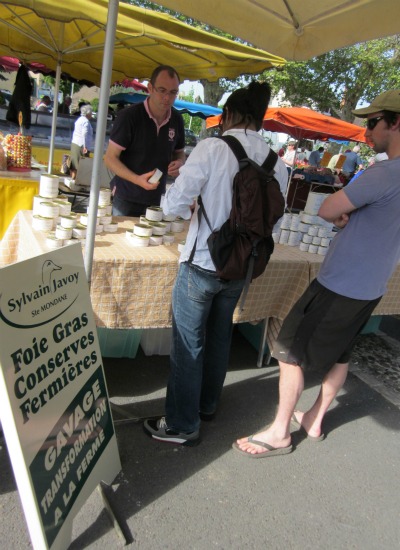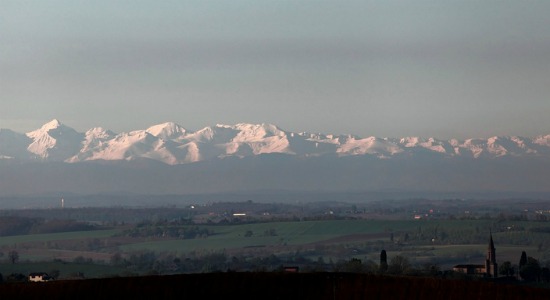Off the Road in the South of France
Ernest Hemingway popularized the cosmopolitan lifestyle of Paris, but he missed out every day he wasn’t walking through the forested hills of Périgord
/https://tf-cmsv2-smithsonianmag-media.s3.amazonaws.com/filer/20120511102035ClassicDordogneSMALL.jpg)
Ernest Hemingway popularized the cosmopolitan lifestyle of idleness, coffee shops and people-watching on the noisy boulevards of Paris. The author wrote some decent books in the process, but I still think Hemingway missed out every day that he wasn’t walking or cycling through the forested hills of the Périgord, the large agrarian region just east of Bordeaux and north of Spain and famed for its wild truffles, cottage fois gras industry and pre-modern cave art. There is a cafe here in the village of Saint Julien de Lampon, where we have a house for a week, and we can sit there if we like, watching the church tower and the villagers coming and going from the butcher shop, but I’ve got better ideas for the next six weeks that I’ll be traveling here, like these:
Search the shallows for pike. They’re as big as logs, mean as crocs and hungry as bears: northern pike. These spectacular predators eat ducks and rodents and will attack other fish their own size or greater, and they live in the Dordogne River. In his college days, my dad spent some time canoeing in Minnesota’s Boundary Waters, where he and the boys went skinny dipping in pike-populated waters and jokingly called it trolling. Here, I’m keeping my shorts on when I go swimming. Probably the best way to see a pike is to peer off bridges into the slow current or stalk along the bank while watching the sloughs and backwaters for what seem to be submerged logs drifting upstream. I’ve already seen several near the village. Climbing out on horizontally leaning tree trucks and looking straight down on a slow pool for 30 minutes is a good method—and when you see one of these monsters drift past in the Dordogne, you can be sure that you’ve met the king. Or maybe you haven’t—because we just read in the papers that a local angler caught a 100-pound wels catfish recently, and the wels isn’t just a duck-eater; supposedly, it has swallowed children.
Ride a bicycle. They’ll hit you with extra luggage fees at the airport for daring to bring a bike overseas (and if you’re especially lucky, like me, they’ll leave it in London overnight), but once you’re rolling on the solid ground of France, a bicycle will set you free. A vast network of small, smaller and smallest roadways crisscrosses the nation. Many are paved paths hardly wide enough for a Fiat that lead through the woods and past forgotten farm houses and crumbling chateaus, along rivers and up mountainsides. Forget your map and just keep rolling–and if the road turns to dirt, don’t stop. It may even disintegrate into a rutted wagon trail or footpath, but almost without fail, just when you thought maybe you were in fact lost, the trail will dump you out again onto the highway. In this scheme of exploration, there is rarely backtracking or getting truly lost. Instead, one becomes familiar with a rare but thrilling déjà vu sensation—after a hungry day of pedaling in circles on unmapped roads—of winding up by accident right back again where you started.
Walk into a Cave. People have been doing it for millennia here, and in many nearby grottoes the paintings of pre-modern people remain on the walls. My nephew, who is seven, can paint better than they did, but to see bison, mammoths and bears scrawled by human hands 150 centuries ago is an awesome reminder of the reality of a history most of us only know from textbooks. The Lascaux, Pech Merle and Cougnac caves are three of the most famous. Lascaux, closed to the public, is only viewable via a reproduction of the original art, while at Pech Merle, you can see the real thing—plus animal bones and human footprints.
Tour the farmers markets. French chefs have taken crocks of credit over the years for wowing diners with their classic sauces, bricks of pate, rustic soups, wild game and pastries—but let’s face it: It’s the open air farmers markets where French food really comes from. Even the tiniest villages here host weekly assemblies of gritty-fingered peasants selling their cherries, beets, potatoes, walnuts, berries and greens. In Saint Julien there is a regular paella vendor, and makers of cheese, sausage, fois gras and wine do business here, too. Yeah, you could eat yourself ill at any local restaurant, where roughage from the garden and stewed potatoes soak in butter and duck fat. I say forget dining out, because no meal here is more gratifying than one cooked at home from a canvas sack of market goodies and eaten on the lawn until the sun sets at 10. The Saint Julien market arrives each Thursday. Souillac’s market is Friday. Sarlat, the nearest big town, has its market on Saturdays and Wednesdays. In, Gourdon, a medieval town on a hilltop, market days are Saturday and Tuesday.

American tourists negotiate for fois gras---or fatty duck liver---at the Saint Julien farmers market. Photo by Alastair Bland.
Buy bulk wine in a plastic jug. Fine restaurants in America are now serving wine on tap for $4 a taste, but in reasonable France, they’ve been selling table wine in bulk for ages. In the rear shadows of many wine shops (behind all the labeled commercial bottles), you’ll find a spigot coming off a barrel of some local plonk, offering perfectly decent if cheap wine by the pint, liter or gallon. Fill your jug, screw on the cap and go find a bench along the bike path or a grassy knoll above the river.
Hunt the cep. Europe’s favorite wild mushroom floats in three sing-song syllables off the tongues of Italians, but in France, the porcini is just the cep. No matter. This renowned mushroom is the same across all Old World borders—fat pig-like stumps with white stems and tawny brown caps that bulge from the leaf litter beneath chestnut trees. That blue and beaten-up Renault parked at the edge of the forest? That’s probably a cep hunter’s. Follow quietly, track him down and discover his secret patches. Better not collect your own unless you really know your shrooms, but there’s no harm in taking a walk in the woods—though you’re wasting your time if you look up. Other fungi hunting opportunities: Its season is the winter, and if you come here in December, remember that the Périgord black truffle grows among hazelnuts and oaks. You’ll need a good dog to sniff them out, although some walkers watch for vertical columns of tiny flies just above the ground—often a clue that a cluster of the world’s most pungent mushroom is hiding below. Warning: Truffle patches are often on private property, and truffle hunter landlords may shoot trespassers.
Go to Spain. The cheese is just as smelly. The rustic country cuisine is by and large the same. The people, like their French neighbors, live by espresso and wine. But the crowds are less and cost of living about half. The mountainous border along the Pyrenees is just 200 miles south of here, and three days ago as my plane landed in Toulouse, I caught sight of these peaks, still buried in snow in this exceptionally late-blooming spring. Even Hemingway ditched his beloved France for Spain. Soon, so will I.
/https://tf-cmsv2-smithsonianmag-media.s3.amazonaws.com/accounts/headshot/Off-Road-alastair-bland-240.jpg)

/https://tf-cmsv2-smithsonianmag-media.s3.amazonaws.com/accounts/headshot/Off-Road-alastair-bland-240.jpg)